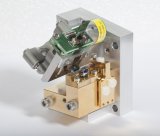Fraunhofer IPMS develops MEMS technology for spectroscopy in the medium infrared range
The Fraunhofer Institute for Photonic Microsystems IPMS already presented a mobile MEMS scanning grating spectrometer in sugar cube format at the leading international trade show for optical technologies Photonics West; the spectrometer can be used to study gas-shaped, liquid and solid materials by analyzing light in the near infrared range (950 nm to 1900 nm). At this year's Photonics West trade show, the scientists will be introducing a novel approach that also uses MEMS technology for spectral analysis in the medium infrared range (3 – 12 µm). In this region many chemical substances that are important for security monitoring purposes feature unique and characteristic absorption lines. Thus different hazardous materials can be quickly detected and quantified using a compact mobile sensor system.
Environmental contamination, industrial accidents or terror attacks: there are many types of events that can put the health of humans and the environment at risk due to the leakage of hazardous substances. The assessment of and timely response to possible risks requires that the type and concentration of potentially hazardous substances can be qualitatively and quantitatively determined as quickly as possible. Spectroscopy, which involves the illumination of materials followed by an analysis of the intensity and spectral composition of the light that is affected by the sample, is predestined for this purpose. This is possible because the measurement process using electro-magnetic radiation represents a no-contact procedure and can also be applied to many different solid, liquid or gas-shaped materials as each molecule has its own unique infrared spectrum (»fingerprint«). The challenge for researchers is to combine this measurement technology into a robust and compact design, and enable it to cover the largest possible wavelength range in the medium infrared range, in order to identify the greatest number of relevant gases or more complex molecules.
To meet these requirements, Fraunhofer IPMS and 17 other project partners from nine countries are working on the development of a novel, handy variable frequency monochromatic light source for the medium infrared range as part of the European joint venture research project »MIRIFISENS – Mid Infrared Innovative Lasers for Improved Sensor of Hazardous Substances«. It forms the technological basis for the development of handy spectrometers that can detect the concentration of different hazardous materials quickly on location. The heart of the system consists of a miniaturized quantum cascade laser (QCL), which is being developed by researchers of the Fraunhofer Institute for Applied Solid State Physics IAF in Freiburg. The QCL covers a large range of the wavelengths that are important for the spectroscopic »fingerprint« in the medium infrared range. To set the light of the QCL to the defined wavelengths, scientists at Fraunhofer IPMS developed a highly reflective diffraction grating with a diameter of 5 mm as well as the belonging control electronics. The micro-mechanically manufactured diffraction grating acts as the quantum cascade laser's variable frequency external resonator. It allows for the tuning of laser wavelengths with a frequency of 1000 Hz, with a variable frequency range of up to 20 percent of the central wavelength.
In this way, the sample can be irradiated with different wavelengths in the time multiplex, and conclusions can be drawn with regard to the type and concentration of the hazardous materials using the »fingerprint«. Fraunhofer IPMS' project Manager Dr. Jan Grahmann explains the benefits of MEMS technology as follows: »Electrostatically-driven MEMS grating mirrors are much more compact than galvanometer scanners, make almost no sound and allow for very high scanning frequencies due to their low weight. In combination with miniaturized laser sources, they are ideal for integration into mobile handy sensor systems, simple measurements on location and for integration into industrial measurement technology at production and processing facilities.«
At the Photonics West in San Francisco, which is held 7 - 12 February 2015, Dr. Jan Grahmann will present the technology to a scientific community on 12 February 2015 as part of a presentation with the title »Large MOEMS diffraction grating results providing an EC-QCL wavelength scan of percent«. Visitors to the accompanying exhibition, which takes place from 10 - 12 February 2015, will also have an opportunity to get a first-hand look at the possibilities of miniaturization using MEMS Scanning Grating Technology at the Fraunhofer IPMS' stand 4409 in the North Hall. That is where the Institute will present a further development of the scanning grating spectrometer for the NIR range, which was first introduced two years ago. With a volume of only 2.1 cm³, this system, which is demonstrated using the example of distinguishing different white powders such as sugar, salt or artificial sweetener, is 30 percent smaller than a regular sugar cube, and is controlled with a normal Smartphone. It provides measurements in the wavelength range of 950 nm to 1900 nm, with a spectral resolution of 10 nm. Thus the technology is interesting for the analysis of a variety of different organic compounds and numerous applications, such as portable measurement devices for the food industry, mobile medical and pharmacological analysis devices, industrial in-situ quality testing or early warning and monitoring systems in security applications and building management.
 Fraunhofer Institute for Photonic Microsystems
Fraunhofer Institute for Photonic Microsystems